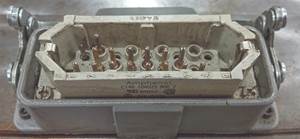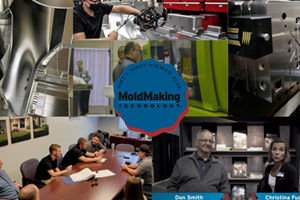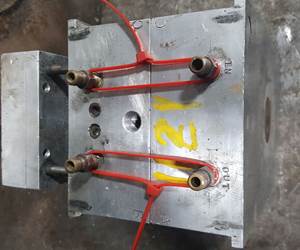Under the Scope: The Right Way vs. the Fast Way
There is a delicate balance between meeting the customer’s request for a fast turnaround and completing a proper welding repair.
Tool welders often have to make the choice between doing a welding repair “by the book” or using the fastest method to get the job done. These decisions can affect proper welding surface preparation, filler choice and welding process selection. It’s a delicate balance between meeting the customer’s request for a fast turnaround and taking the proper time to complete a project. Using an experienced welding service for micro-TIG and laser welding is often essential, because these operations are experienced in overcoming challenges while providing the fastest possible turnaround.
Let’s take a look at the three aspects of a welding job that are most impacted by the decision to do a proper weld repair or use the fastest method possible:
Surface preparation. Cleaning an area to be welded, and carefully grinding out burrs and rough areas is an essential part of welding. Anything problematic to the welding process needs to be removed, if possible. This is the right way to do it. However, sometimes this is not always practical, given the nature of the area being welded.
In my shop, most customers wait on site while their work is completed. If the customer is waiting for his job, it usually means that a press is down back at the shop and a quick turnaround is needed. So to meet this need, I push the job along faster by using my experience. I always fully clean an area to be welded of any oil or grease. This step cannot be amended. However, if the repair has sensitive areas that could get damaged during grinding, my only option is to use the power of my machine during the welding process to burn down any sharp or rough areas. Using the capabilities of a welding machine to compensate for these conditions is not recommended, but it is often the only way to achieve a successful repair under certain circumstances.
Filler rod choice. Proper filler rod selection is dependent upon the recommendations of the rod material manufacturer. Again, this is the right way. Unfortunately, many times the exact steel type used to make the mold is unknown, especially when the mold has been inherited from another molder. If the repair job is an emergency, trying to pin down the exact steel type when you have little information takes more time than you can give.
When dealing with a mold in service, this is usually not a problem, as most customers are satisfied with use of a filler rod that matches the hardness of the base material. 420SS is the natural “go-to” rod when the base steel is unknown, because its hardness is often reasonably close to that of steels like S-7 and H-13. However, every effort should be made to correctly match the filler rod to molds in the process of being built, because they still need to go through heat treatment.
It can also be difficult to find an exact match of filler rod for every type of material that is on the market, and sometimes certain required diameters are not readily available. For example, you may need a 0.015-inch-diameter rod, but the filler is only available in 0.035 inch. These are situations tool welders face every day and are best tackled with job experience and customer input.
Process selection. Whether a customer wants the job to be laser or micro-TIG welded also can make a difference in time. Laser welding large buildups is more time-consuming than TIG welding. Micro-TIG welding is not as precise and creates exponentially more heat than laser welding, but this tradeoff may be worth it, depending on the task at hand. If the block is large and the area to be repaired is large, it is often faster to use a TIG machine.
As a welder competent in both, I know the effects of each process and which process I can or cannot use effectively in certain repairs. If the customer has the time and the area to be welded is sensitive, then laser welding is the only viable option. If the customer needs the job completed immediately because his press is down and the area to be repaired is large, then laser welding might not be the best option. The right decision depends on each particular job and situation. Here is where having both types of equipment and experience with both processes is key.
No matter the type of welding job or which welding process you choose, always make the customer aware of all the challenges. It is the customer who should make the final decision on which methods are used to repair his molds. A welder’s job is to present all of the possibilities and help the customer make the best decision for the project.
Related Content
How to Maintain Heaters, Thermocouples, Valve Gates and Controls
An examination of real-world problems and solutions involving hot runner system maintenance.
Read MoreMost-Viewed Content of 2022
The most popular MoldMaking Technology content according to analytics reports over the past 12 months.
Read MoreWhat You Should Know About Injection Mold Safety Straps
Every mold should have one in order to be safe and OSHA compliant.
Read MoreProducts and Services for Multiple Moldmaking Needs
New year, new technology roundup! Featured here is a collection of product offerings, from profile milling cutters to industry-specific CAD/CAM software to innovative hot work tool steels.
Read MoreRead Next
Under the Scope: Cracking Demystified
Cracking in tool welding is a common challenge, but it is one for which risk can be minimized.
Read MoreHow to Use Strategic Planning Tools, Data to Manage the Human Side of Business
Q&A with Marion Wells, MMT EAB member and founder of Human Asset Management.
Read MoreReasons to Use Fiber Lasers for Mold Cleaning
Fiber lasers offer a simplicity, speed, control and portability, minimizing mold cleaning risks.
Read More














.jpg;maxWidth=300;quality=90)

_300x250 4.png;maxWidth=300;quality=90)








_970x250 4.png;maxWidth=970;quality=90)